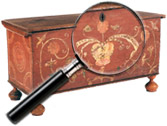|
|
Charles Henry Ebert (American 1873 to 1959)
Charles Ebert studied in New York City and Paris. When he returned to New York City in 1896, he opened a studio, and became an illustrator for Life Magazine. He and his wife Mary Roberts lived in Greenwich, CT until 1919 and the moved to Old Lyme. Ebert is best known for his painting of Monhegan Island. Today his paintings can be found at the Farnsworth Museum, [...] Click here to continue reading.
Drew Ebelhare – Paperweights
“Ebelhare’s next inspiration came from a copy of American Glass Paperweights and Their Makers. He was not impressed by the work of most of the glassworkers featured in Jean Melvin’s historic work, but the millefiori of Charles Kaziun caught his eye. At a meeting of the Texas Bluebonnet Chapter of the PCA later that year, he met former chapter President Harvey Jones, who was to become instrumental in his growth [...] Click here to continue reading.
Charles Warren Eaton (American, 1857 to 1937)
The American landscape artist, Charles Warren Eaton, remains one of the best kept secrets of the art market. Although his works are included in many public collections across the United States including the National Gallery of Art, the National Museum of American Art, the Brooklyn Museum, Butler Institute of American Art, and the Cincinnati Art Museum, he is virtually an unknown except to the savviest of collectors. [...] Click here to continue reading.
Seth Eastman (1808-1875)
Seth Eastman was a West Point graduate and later a teacher at the academy. He spent five years working on a six volume set with 300+ illustrations authorized by Congress which recorded all of the Indian tribes of America entitled Historical and Statistical Information Respecting the History, Condition and Prospects of the Indian Tribes of the United States.
Information courtesy of Cowan’s Auctions Inc.
Ralph Eleaser Whiteside Earl (1788-1838)
Ralph Eleaser Whiteside Earl was born in New York, the son of famed portraitist Ralph Earl (1751-1801). He likely learned much from his father, but early in his career, he also studied with John Trumbull and Benjamin West in England. He spent 1814-1815 in Paris where he met John Vanderlyn and studied the greats at the Louvre. Upon his return to the U.S., Earl toured the south, painting portraits. [...] Click here to continue reading.
Thomas Eakins (1844 to 1916)
Born in 1844, Thomas Eakins grew up in Philadelphia and later studied in Paris. His focus on portrait paintings grew from his appreciation of the candid humanism seen in 17th century Dutch and Spanish paintings. Instead of focusing on lavish, ornate detail aimed to impress the viewer, Eakins shows extreme but honest human emotion in his portraits. His talent and ability to create a somber yet frank tone [...] Click here to continue reading.
E. Joy Morris was one of Philadelphia’s smaller carousel builders. He created less than two dozen carousels during his career from 1896 to 1903. He sold his carousel business to the Philadelphia Tobbogan Company in 1903. He passed away in 1929. Playful saddle decorations were popular with Morris.
Mabel Dwight (1876-1955)
Mabel Dwight was born in Cincinnati, raised in New Orleans, and studied at the Hopkins Art School in San Francisco. A religious socialist, she often produced satirical works about life in the city. She worked in oil, lithography and printmaking. She died in Sellersville, Pennsylvania in 1955.
Information courtesy of Cowan’s Auctions Inc.
William Herbert “Buck” Dunton (1878-1936)
Buck Dunton was born in Augusta, Maine on August 28, 1878. Having spent much of his time in the woods of Maine with his grandfather, he developed a keen interest in the outdoors, hunting and animals that would last throughout his life. Dunton began sketching on his excursions, and by the age of twelve, he was selling illustrations to his local newspapers and to the Boston Sunday Globe.
[...] Click here to continue reading.
Raoul Dufy (French 1877 to 1953)
In 1900 he studied at the Ecole des Beaux-Arts in Paris and experimented with Impressionism admiring the works of Monet and Pissarro, but by 1904 he had adopted the Fauve style of Matisse and began to work in richer colors. He developed his own theory of coleur-lumiere, (heightened ambient color/light) and was the only Fauve whose work retained this brightness. About a year after the war, around 1919 [...] Click here to continue reading.
|
Recent Articles
- Charles Alfred Meurer – American Artist & Tromp L’Oeil Artist
- Sendak, Maurice – American Artist & Writer
- Godie, Lee – American Artist
- Davis, Vestie – American Artist
- Bartlett, Morton – American Artist
- Mackintosh, Dwight – American Artist
- Evans, Minnie Jones – African-American Artist
- Mumma, Ed (Mr. Eddy) – American Artist
- Nice, Don – American Artist
- Savitsky, John (Jack) – American Artist
- Gordon, Harold Theodore (Ted) – American Artist
- Dial, Thornton – African-American Artist
- Doyle Sam – American Artist
- Johnson, Lester Frederick – American Artist
- Finster, Howard – American Artist
|
|
